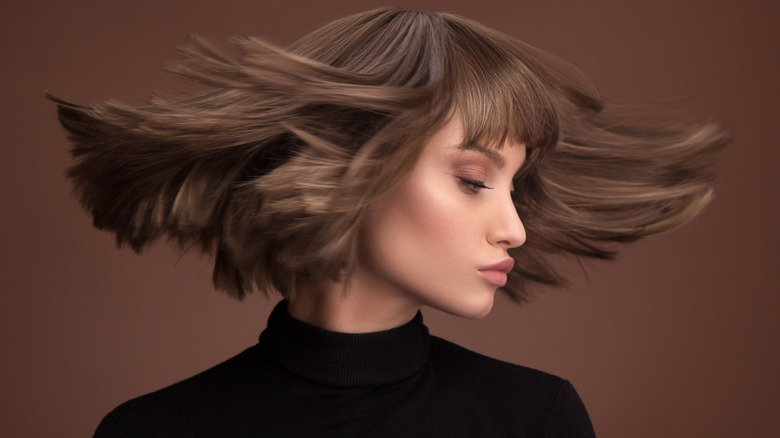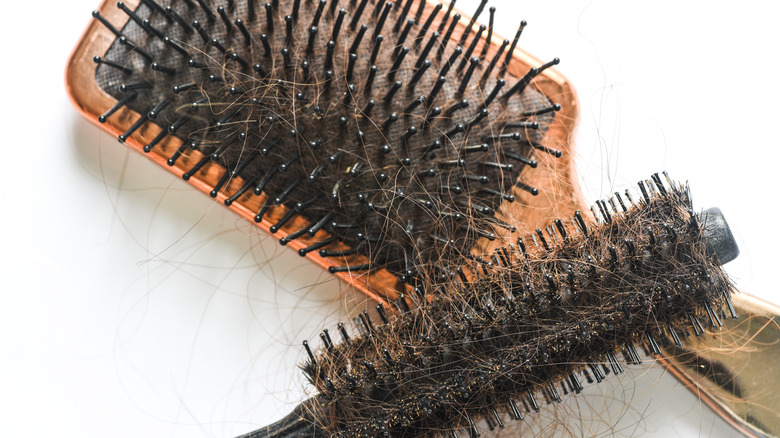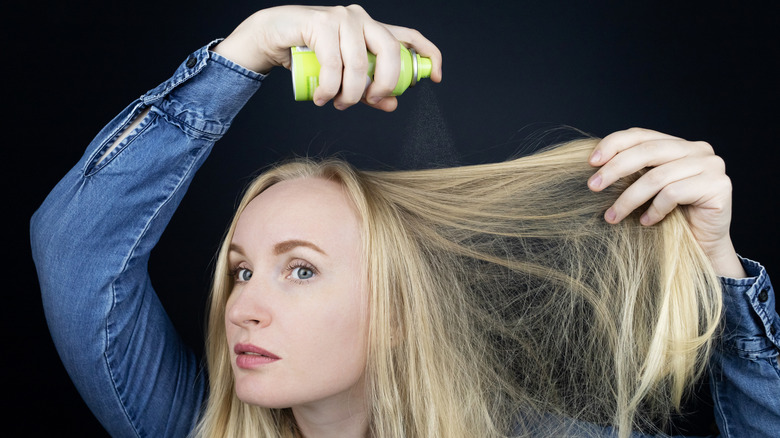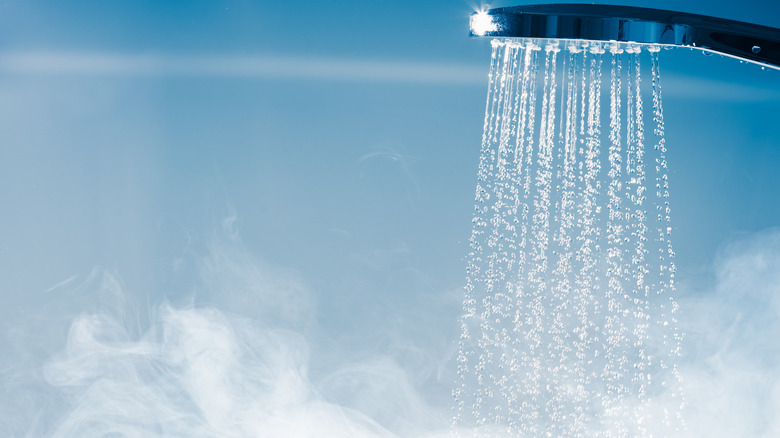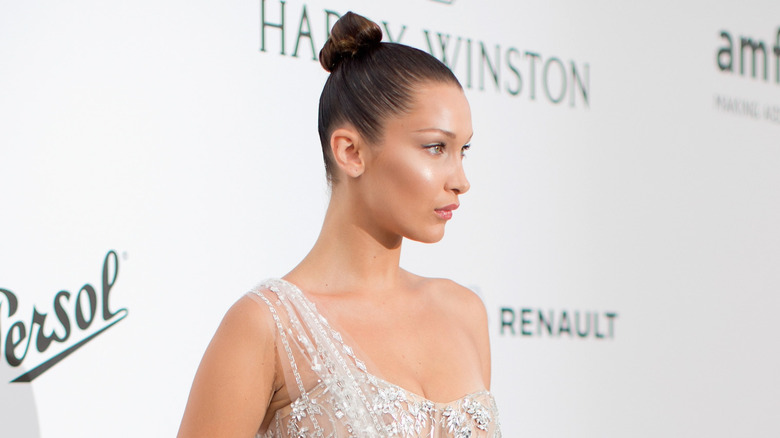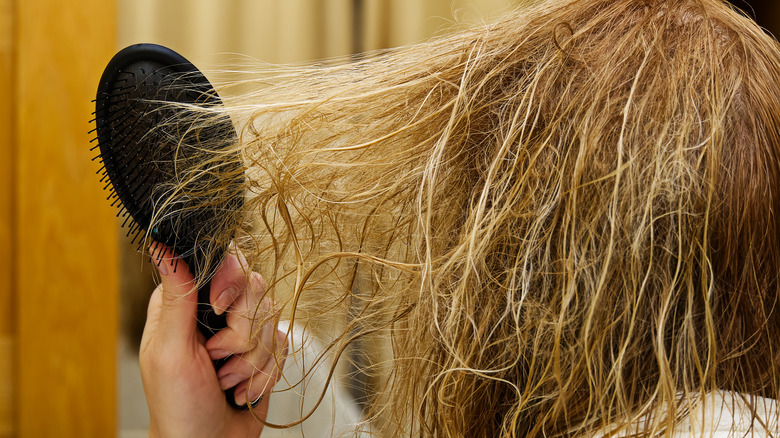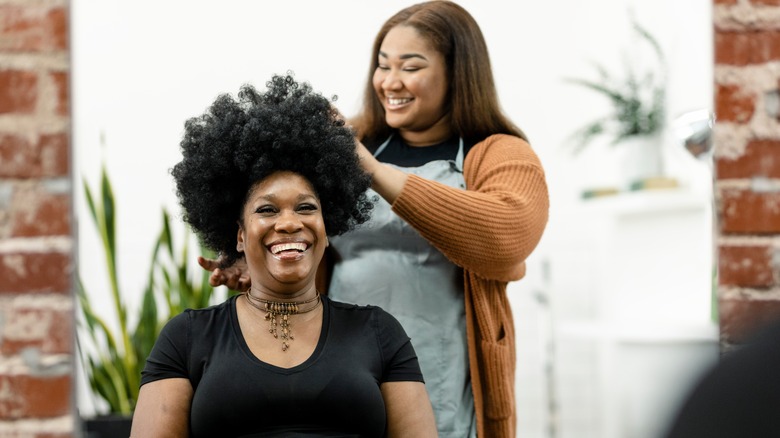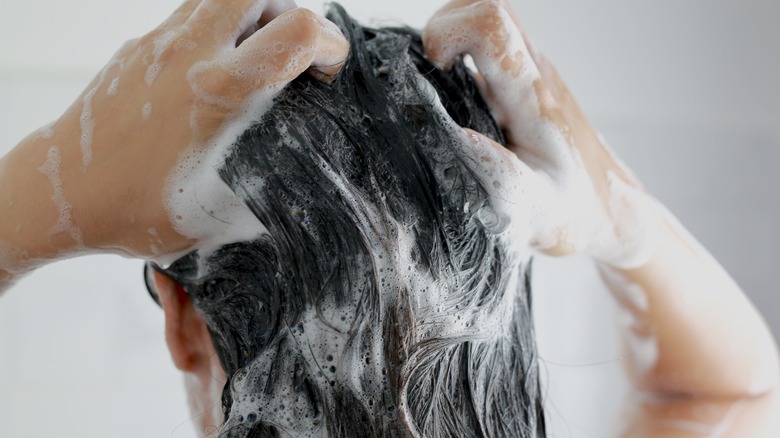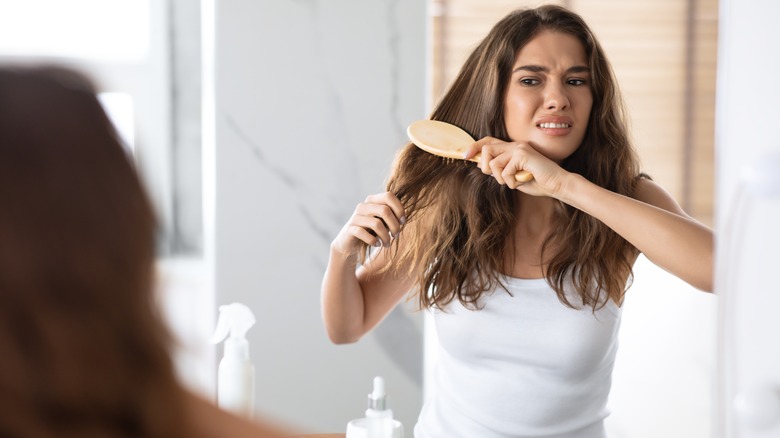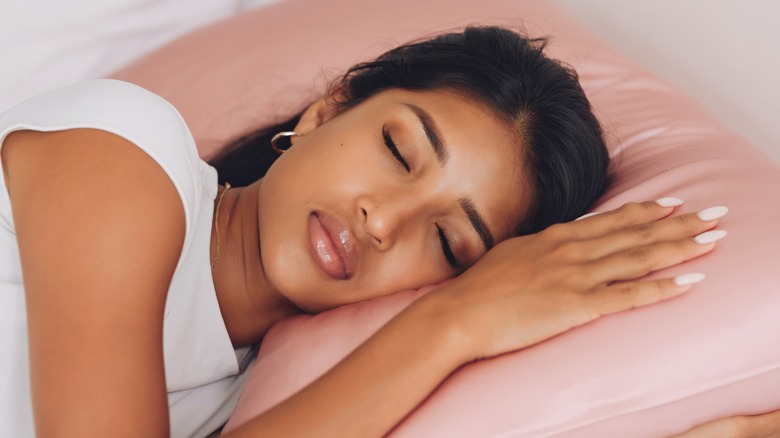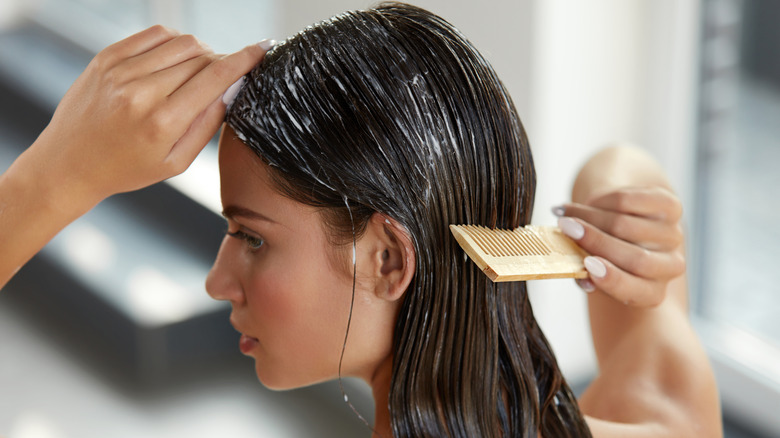How These 15 Bad Habits Could Be Ruining Your Hair
We may receive a commission on purchases made from links.
A big part of self-care for most people also involves hair care. No one wants their hair to look bad or be unhealthy, which is why most of us have the sacred haircare rituals that we stick to. However, what might be the best routine for some could be the absolute worst for somebody else. "Before choosing any hair care regimen, it is essential to analyze your hair type and identify the causes for hair issues," dermatologist Dr. Harish Koutam reveals (via Skinkraft).
While all of us know the importance of washing and conditioning our hair, there are plenty of habits that can damage your hair without you even being aware of them. Luckily, we researched the most common hair mistakes people make, and some of these are bound to surprise you. Of course, it's impossible to always do everything right when it comes to keeping your hair healthy, but being aware of the things that can harm it is a step in the right direction!
You're not cleaning your hairbrush regularly
We all know how important it is to clean our towels and makeup brushes, but many of us neglect cleaning out hair brushes regularly. In fact, when you're picking the right hairbrush for yourself, make sure that it's one you can clean easily. While we've all seen hairbrushes that get dirty from hair, product buildup, skin, and dust, "additional bacteria and fungus can grow on the material inside the brush," trichologist William Gaunitz tells The New York Times. Using dirty tools on your hair will spread buildup and bacteria, and your scalp can get inflamed, resulting in hair fallout.
Now you're probably wondering how often you should wash your hair brush. While there is no general number, if you don't use too many hair products daily, you can get away with washing it every two to three weeks. However, ensure you regularly inspect your brush, and if you see buildup, give it a bath. The first thing you should do is remove any hair on it (something you should do daily), after which you soak your brush in water to which you have already added clarifying shampoo. A good tip is to use an old toothbrush to scrub between the brush bristles properly. Once you rinse it, let it dry and spritz it with a tiny bit of disinfectant.
You're using dry shampoo too often
Using dry shampoo is an easy way to give your hair the appearance of freshness, but if you are using it regularly and not washing it out properly, it can lead to weaker hair. "Buildup of the dry shampoo can trap unwanted bacteria and create unhealthy yeast leading to developing abnormal scalp conditions, and the product buildup slows down cellular turn over, and distribution of nutrients which weaken the hair follicles," trichologist and colorist Bridgette Hill tells Well + Good.
To prevent this, make sure you use a clarifying shampoo every time you have dry shampoo in your hair. Another great way to ensure you shampoo properly is to use a shampoo massager — trust us, it does a much better job removing buildup than our fingers ever could. While any massager will work, we recommend MAXSOFT's Hair Scalp Massager Shampoo Brush, which you can get for $7.98 on Amazon.
You wash your hair with hot water
For many people, nothing is as relaxing as a hot shower. However, when washing your hair, using extremely hot water is one of the worst things you can do. "When hot water is used to wash hair, your hair follicles are exposed to environmental and oxidative damage, which can lead to hair fall. Hair fall accelerates due to the loosened grip of the damaged hair roots. This can also result in premature greying," award-winning dermatologist Hasan Benar tells Byrdie.
Health Shots reveals that if you use hot water on your hair regularly, your hair will end up drying out, you will notice increased hair loss, it might cause scalp inflammation, and you could get dandruff. Per Better Not Younger, the perfect water temperature for your hair is around 100 degrees Fahrenheit (around 37 degrees Celsius). If you want your hair to be even healthier, make sure you always do your final rinse with cold water to close your hair follicles and maintain scalp health.
You are wearing tight ponytails/buns on a daily basis
Anyone with long hair knows how nice it is to get it out of your face if you're at home, sleeping, or just running errands. We often opt for super tight ponytails and buns, which have also become ultra-trendy thanks to the rise of the "clean girl look" frequently seen on models like Hailey Bieber and Bella Hadid. Unfortunately, wearing your hair in a tight style regularly is bad for it and can cause excessive hair loss.
"Any tightly pulled hairstyle can cause traction alopecia. So not just tight ponytails, but also buns, braids, and hair extensions," regrowth expert Lars Skjoth tells Mane Addicts. "When the hair is pulled into a tight hairstyle, it creates tension between the hair and the follicle and can tear the follicle. Repeated tearing can create scars in the follicle, and this damage will impede hair from growing there."
If you notice a lot of shorter hairs, you might think that you're growing baby hairs, but in reality, you can also be experiencing hair breakage from a repeated tight hairstyle. Another sign of traction alopecia is losing hair around your hairline. "Some people also experience patchy hair loss in places around the hairline that have been pulled tight by ponytails, braids, or other hairstyles," board-certified dermatologist Corey L. Hartman, M.D., tells Allure.
You're brushing your hair while it's wet
A lot of people tend to brush and untangle their hair in the shower before or after applying conditioner; however, hair experts recommend against that. "The number one thing to keep in mind when brushing your hair is that it is in the most vulnerable and sensitive state when it's wet," certified trichologist and hairstylist Shab Reslan tells Byrdie. "Brushing it in that condition can actually overstretch, overpull, and ultimately tear your hair. Hair is in its strongest state when it's dry."
Because of this, it is essential that you brush out your hair before you wash it — this way, you won't encounter any unexpected tangled-up patches. Once you wash it, you should also wait until it dries before brushing it. "The best time to brush your hair is when it is almost or completely dry. But if you have tangles after washing it or after a swim, you can use a wide-tooth comb on your wet hair to restore order but make sure it has smooth tooth ends so you don't irritate your scalp," hairstylist Rob Reeves tells VS Sassoon.
You're not using heat protection when using hot tools
If you use heat tools but not heat protectant, don't be surprised that your hair gets damaged quickly and that you get split ends almost weekly. Per The List, heat protectants have silicones that coat the hair cuticle protecting it from the high temperature. "Heat protectants create a barrier between the hair and the hot tool," celebrity hairstylist Justine Marjan tells HelloGiggles. Regardless of whether you use heat tools on a daily basis or once a month, adding that extra step of applying heat protectant is worth it.
However, even the best heat protectants can't protect your hair forever. If you are using heat tools regularly, you will end up damaging your hair. "Ultimately, if you over-use heat, you'll see damage. Most people will eventually see damage over time, though it'll take much longer and be less likely with the right heat protectant." Nikki Neubarth, chief operating officer and head of product development at UNITE Hair, tells Mane Addicts.
You're not protecting your hair in the sun
Speaking of heat damage, many people completely forget to protect their hair from the sun. "If your hair undergoes prolonged exposure to the sun, the UVA and UVB rays can damage the outside cover of the hair strand, called the cuticle. It can damage the hair shaft and lead to discoloration, early greying, dry and brittle strands, broken or split ends, thinning and frizziness," dermatologist Dr. Ameesha Mahajan tells Vogue.
While protecting your hair from the sun is beneficial year-round, the one season you should really focus on this is summertime. Like the rest of your skin, the top of your head can also get a sunburn, and besides being incredibly painful, that can also result in weaker hair. "The best way to protect your hair in the heat is to wear a hat," celebrity hairstylist Adam Reed, who is also the founder of the haircare range Arkive, tells Get the Gloss. "If hats aren't your thing, wrap your hair using headbands, turbans, and headscarves – super easy to do, and they look absolutely brilliant. That will protect your hair from direct sunlight, but you still need to apply heat protection onto the hair directly."
You're not getting regular hair trims
It's safe to say that everyone has heard this before: in order to have long and healthy hair, you need to get regular trims. While this might seem counterintuitive (after all, you're trying to grow your hair out), hair experts agree that it is true. Once split ends form, the hair will continue splitting into two strands towards the root. "The damage will just continue up the shaft, so by the time you [eventually] go for a cut, you'll end up having to cut more than you would have if you'd just bitten the bullet with the trim," Erika Wasser, founder and CEO of Glam & Go, tells Insider.
Per Healthline, if you're trying to grow your hair, get it trimmed every 12 weeks. However, schedule an earlier appointment if you notice split ends before that. Your hair health depends on many factors, so it's difficult to give a time frame for hair trimming that works for everyone.
You're rubbing your wet hair with a towel
As previously mentioned, hair is at its most sensitive when it's wet. Because of this, you need to treat it gently otherwise, you will cause breakage. Rubbing it vigorously with a towel is a habit you should really work on eliminating. "This can worsen split ends and cause small craters along the hair shaft, weakening the hair," celebrity hairstylist and author Monae Everett tells HuffPost. "Noticeable signs of damage are dry hair and frizz. Frizz is a major indicator of damaged, dry hair in need of moisture."
However, this doesn't mean you're not allowed to use a towel — you just need to be more gentle with it. "After a shower, rather than wringing or rubbing, gently squeeze water out with an absorbent hair towel," the founder of microfiber towel brand Aquis, Britta Cox, tells Byrdie. "Then wrap the hair up and let the hair towel absorb additional water for 10 to 15 minutes, depending on the type of hair — fine hair will require less time, while thick or curly hair will require more. This causes the least amount of friction and allows hair to dry quickly without damaging the cuticles."
You're overwashing your hair
How many times per week you wash your hair depends on your hair type, the products you use, as well as your needs. However, overwashing your hair leads to hair damage, so hair experts recommend that you don't wash your hair unless you really have to. "If you seem to be getting more split ends than usual, this could also be a sign of over-washing. Wet hair is so extra susceptible to damage and breakage, so the more you wash it, the more opportunity it has to break," celebrity stylist Tonya Le tells Insider.
While there is no uniform answer regarding how many times per week one should wash their hair, many experts recommend a maximum of three to four times. "Wash hair about three to four times a week with the correct shampoo and a conditioner/mask made for color-treated hair," Le says. "And, in between washes, refresh your hair with a dry shampoo of your choice."
You're detangling your hair from the root down
A lot of hair breakage happens when brushing your hair, especially if you have tangled patches to tackle. While this might seem like a given, plenty of people don't know that whenever you're brushing your hair, you should start from the bottom. Hairstylist Kendall Dorsey tells Byrdie that "the biggest mistake many people make when detangling hair is starting from the root instead of ends. Instead, start at the bottom and work your way up. That way, when you reach the root, you'll have a smooth foundation to glide down."
Apart from the proper technique, using the right tool is also crucial. "Tail combs and other small-tooth combs can cause severe damage and breakage to your strands," Dorsey recommends. "The best way to detangle hair is to use a paddle brush or wide-tooth comb as they are much more gentle on the hair."
You're not sleeping on a silk/satin pillowcase
There are many benefits of sleeping on a silk or satin pillowcase, and we have already separately covered which of the two options is better for your hair. However, both will protect your hair during sleep much more efficiently than a cotton pillowcase which tends to cause more harm than good. "Friction from cotton can disrupt the cuticle layer, leading to frizz, breakage, sleep crease, and dry strands," celebrity hairstylist Justine Marjan tells MarthaStewart.com. "Silk doesn't absorb or pull moisture from your skin the way traditional cotton pillowcases do, leaving hair hydrated and frizz-free."
Besides not damaging the hair, silk and satin pillowcases help better distribute your hair's natural oils. "When you lie on a silk or satin pillowcase, the natural oils from your hair are maintained, rather than soaked up, leaving your hair nourished (instead of dry and without shine)," hair colorist and a member of R+Co Collective, Richy Kandasamy, tells MarthaStewart.com.
You constantly touch or twirl your hair
A hair habit most people don't think much about is twirling or constantly touching your hair. Many of us do this, but it's not our fault. It's natural. You may find yourself doing this to ease anxiety in your life, or perhaps you do it while laying in bed at night before falling asleep. Either way, we may want to do something about it. While this habit might be a difficult one to break, your hair will thank you once you do.
"Constant mild pulling on the follicle will slowly traumatize the hair," dermatologist Lindsey Bordone tells RealSimple. "Twisting and twirling the hair can damage the cuticle layer, leading to breakage and split ends. It can also lead to knots, tangles and matting." trichologist Stephanie Sey tells Refinery29, adding that this can cause traction alopecia. You may not notice any bad consequences immediately, but in the long run, playing with your hair constantly affects it negatively. To work on getting rid of this habit, consider starting up a hobby like crocheting or using a fidget toy to keep your hands occupied at times when you would resort to twirling your hair.
You're not eating enough healthy fats and protein
You can use the best hair products and minimize all the physical stress your hair might be experiencing, but if you're not growing healthy hair to begin with, all of this might be in vain. A healthy diet is crucial for the growth of healthy hair, which means a regular protein and healthy fat intake. "A protein-rich diet is so important to help grow strong hair," Lars Skjoth, founder and lead researcher at Harklinikken, tells AEDIT. "Your hair loves nutrient-dense, unprocessed foods, like healthy fats found in avocados, fatty fish, nuts, and yogurt." Trichologist Stephen Pullan explains to RealSimple that "protein is the building block of hair because hair is keratinized protein."
Nutritionist Sydney Greene tells AEDIT that those who avoid fats will notice that their hair is dry and damaged. "Gone are the days of fat-free living," Greene says. "Women on intensive low-fat diets can see their hair become brittle and lifeless, so forget about all the low-fat foods and seek out full, healthy fats instead."
You're using too much conditioner (or not enough)
Those with oily hair tend to avoid conditioner, as it makes their hair too flat and shiny, while those with dry hair usually go overboard with it. Finding the right conditioner to use is crucial for your hair's health, as everyone needs this step in their haircare routine. "Some people get conditioner phobic, but the catch-22 is that without conditioner, your hair will become brittle and eventually lifeless," Fox & Jane founder and creative director Lorean Cairns tells Prevention.
Over-conditioning your hair can prevent other products from penetrating your hair cuticle, which is why you might find that oils or serums aren't doing much for your hair. To avoid over-conditioning your hair, use a clarifying shampoo once a week, and when you wash your hair, always apply the conditioner from mid-length to the ends of your hair. Ultimately, you don't want to stop using conditioner, but you can use it less or more based on your needs.
